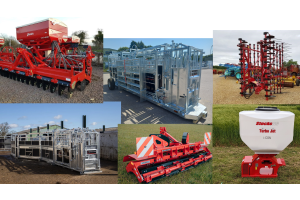Types of shipping containers

In this age where space is scarce, the shipping container is really coming into its own, if not becoming fashionable. Besides serving their more obvious purposes of security, self-storage and transportation, they become bars, art galleries, student accommodation, offices, home gyms and disaster shelters.
Who invented shipping containers?
Malcom McLean, the American businessman, was a transport entrepreneur who developed the shipping container back in the 1950s. Containerisation of goods completely revolutionised the transport and international shipping industry and led the way to mass adoption by the late 1960s when ports, ships and lorries were designed and readily available to carry such cargo.

Uses for shipping containers
Shipping containers are not only used for their original intention for shipping goods. The second-hand container market is thriving with people finding all sorts of uses for containers such as:
-
- Sheds
- Storage
- Workshops
- Offices
- Swimming pools
- Pop up shops and café’s
Mostly, our agricultural and haulage customers use them to securely store or transport large high-value items. As a company, we export agricultural machinery in shipping containers every few weeks to our customers around the globe. We have also developed and welded our own frames to secure dismantled implements whilst in transit.
A small 10ft square size container is perhaps the perfect option for a home office or gym, even in small gardens, and presents a sturdier option than a shed. Check out our 10 ft Container options here: https://www.agri-linc.com/new-10ft-standard-shipping-container.html
In disaster relief zones, these portable containers also are great options for robust emergency shelters and hospitals, providing conflict or natural disaster-ridden areas with comfort and support. Following the series of earthquakes and ensuing aftershocks in Christchurch, NZ, an entire shopping centre was erected from modular containers, providing the community with essential amenities in times of crisis.
Stacking shipping containers
On site, as we have expanded, space has become very limited, and we rely on three 40ft containers to store a large amount of equipment. We have also equipped some with racking to hold stock that can be easily hand-picked, to make more space in our existing warehouse facility. To economize on space, the containers are stacked, which means they take up little extra space. Check out our range of 40ft Storage Containers here: https://www.agri-linc.com/new-40ft-high-cube-shipping-container.html

Similar stacking techniques have been used in densely populated cities for student accommodation solutions, or hotels. These days, shipping containers’ rough, industrial appearance is viewed as appealing to the minds of many modern architects, who transform them into alternative spaces for art galleries, fashionable bars and restaurants. More commonly, for the construction market and similar industries, shipping containers provide robust and secure solutions for the storage of valuable equipment.
We stock a range of shipping containers in a host of different designs, from 10 ft standard sizes, through to 20 ft and 40 ft High Cube options. All our shipping containers are available to buy directly on our website, making it very easy for you to obtain your container solutions.
How do I buy a shipping container?
Firstly, start with what size or capacity do you need. What are you wanting to use it for – shipping or storage or an office!? Then decide what grade of container you need. Does it need to be new or can you make use of a used one?
There are three typical grades for shipping containers:
- New or Single Trip. As the name suggests, these are either brand new or ones that have only been shipped one-way.
- Certified, Cargo Worthy or WWT (Wind & Watertight). These are used containers but are in still very good condition and are used for shipping goods around the globe.
- Used or As-is. These are typically containers that have been decommissioned and are used for storage or a myriad of other purposes.
This guide to typical weights for shipping containers should also be able to help you establish which shipping container is the right option for you.
Shipping container sizes
Dimensions of standard shipping containers:
| Container Types: | Length: | Width: | Height: |
| 10ft shipping container | 9ft 10in (2.99 m) | 8ft (2.44m) | 8ft 6in (2.59m) |
| 20ft shipping container | 20ft (6.06m) | 8ft (2.44m) | 8ft 6in (2.6m) |
| 40ft shipping container | 40ft (12.2m) | 8ft (2.44m) | 8ft 6in (2.6m) |
| 40ft high cube shipping container | 40ft (12.2m) | 8ft (2.44m) | 9ft 6in (2.9m) |
Shipping container weights
Typical Weights of Standard Shipping Containers:
| Container Types: | Max Gross Weight: | Tare Weight: | Payload/Net Weight: |
| 10ft shipping container | 11300 kg/24910 lbs | 1300 kg/2870 lbs | 10000 kg/22,040 lbs |
| 20ft shipping container | 30480 kg/67200 lbs | 2160 kg/4760 lbs | 28320 kg/62440 lbs |
| 40ft shipping container | 30400 kg/67200 lbs | 3750 kg/8270 lbs | 26730 kg/58930 lbs |
| 40ft high cube shipping container | 30480kg 67196lbs | 3660kg 8068lbs | 28,560 kg/62964 lbs |
Weight glossary:
- Tare Weight – the weight of the container without cargo or contents
- Gross Weight – the weight of the container plus the maximum payload it can hold i.e. the maximum total weight of the container
- Payload/Net Weight – the weight of the cargo or contents that a container can hold
Free shipping container calculator
How to lift a shipping container
Inevitably you’re going to need to lift your shipping container into position or maybe you just need to move it. Either way, lifting shipping containers is inherently dangerous and it is imperative that they’re moved in a safe manner at all times. There are various ways you can lift or move your container but the most popular for our clients are:
- Forklift/JCB – Many people own forklifts, and this can be a relatively inexpensive way to shift containers around. However, this may not always be the safest. Although there are huge forklifts capable of lifting containers the short distance between the forks and uneven weight distribution can cause issues.
- Truck crane – This method of lifting containers is preferable to the forklift due to the fact that the truck is more stable than the forklift and is, therefore, easier to lift or move it in a more controlled way. Container lifting chains are used for lifting via the lifting eyes on each corner of the container.
Shipping container security
Whilst shipping containers may appear to be impenetrable; they aren’t. Because people often store valuable things in them, potential thieves think their contents are worth getting at. The most popular form of deterrent is to use a lock box. A lock box is essentially a metal box welded over the padlock clasp with just enough room for your hands to access the padlock and makes it impossible to access the padlock with bolt croppers or angle grinders.
 Courtesy of Bullman Marine
Courtesy of Bullman MarineWe now also stock a STERLING Armoured Steel Padlock, which is an ideal solution for container lock boxes or similar. Be sure to check out our range of Haulage Equipment, including container lifting slings and other equipment to complete your container storage package. Find out more: here
Feel free to contact us if you have any enquiries about our range of Shipping Containers or security products and we will be glad to help. Call 01778 591225 or email sales@agri-linc.com






